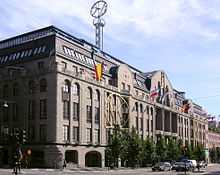Ferdinand Boberg
From Wikipedia, the free encyclopedia

Nordiska Kompaniet department store in Stockholm

Oakhill: Italian embassy in Stockholm

Central Post Office building in Malmö

Söndrumsurnan in Halmstad
Ferdinand Boberg (11 April 1860 – 7 May 1946) was a Swedish architect.[1]
Boberg was born in Falun. He became one of the most productive and prominent architects of Stockholm around the turn of the 20th century.[2] Among his most famous work is an electrical plant at Björns Trädgård in Stockholm, that was inspired by Middle Eastern architecture. The building was converted into a mosque in the late nineties. He also designed Nordiska Kompaniet, the most prominent department store in Stockholm and Rosenbad which today houses the Swedish government chancellery.[3]
Boberg died in Stockholm, aged 86.
References
- ↑ Ferdinand Boberg sv.wikipedia.org. Retrieved: December 1, 2013.
- ↑ Ferdinand Boberg - Architect mit.edu. Retrieved: December 1, 2013.
- ↑ Ferdinand Boberg answers.com. Retrieved: December 1, 2013.
External links
Famous works (in chronological order)
- Rosenborgshuset, Stockholm (1883-1884)
- Bergööska huset, Hallsberg (1887-1889)
- Gävle fire station, Gävle (1890-1891)
- Brunkebergsverket, Stockholm (1892)
- Grünewaldvillan, Saltsjöbaden (1893)
- Värtagasverket, (gas holder and main building), Hjorthagen, Stockholm (1893)
- Cedergrenska tornet, Stocksund, Stockholm (1896)
- Villa Tallbacken, Djursholm (1896), built for the artist Robert Thegerström
- Mosebacke water tower, Stockholm (1896–97)
- Central post office, Stockholm (1898-1903)
- LO-borgen, Norra Bantorget, Stockholm (1899)
- Parkudden, Stockholm (1899)
- Swedish Pavilion at the 1900 Paris World's Fair
- Central post office, Malmö (1900-1906)
- Tulestationen, Stockholm (1902-1906)
- Katarina power station, Stockholm (1903), now mosque
- Värtaverket, (turbine halls and offices), Hjorthagen, Stockholm (1903)
- Swedish Pavilion at the 1904 St. Louis World's Fair, later moved to Lindsborg, Kansas
- Byström's villa, Djurgården, Stockholm (1905)
- The Thiel Gallery, Djurgården, Stockholm (1905), home of the banker Ernest Thiel, now art museum
- Waldemarsudde, Djurgården (1905-1913), built for Prince Eugen who was also an artist, now museum
- NK-villan, built for the Industrial Fair in Norrköping 1906, moved to Nyköping 1907
- Stora Tullhuset, Stockholm (1906-1910)
- Nobelpalatset, Stockholm (1906-1911)
- Villa Arneborg, Trosa (1907)
- Oakhill, Djurgården (1910)
- Uppenbarelsekyrkan, Saltsjöbaden (1913)
- Bjertorp slott, Varaslätten (1914)
- Margareta Pavilion at the 1914 Baltic Exhibition in Malmö
- Nordiska Kompaniet, NK department store, Stockholm (1915)
- Vintra, his own home on Djurgården 1903 to 1925
|
This article is issued from Wikipedia. The text is available under the Creative Commons Attribution/Share Alike; additional terms may apply for the media files.